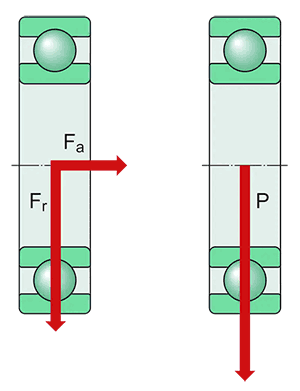When any of the following conditions exist, bearing size should be selected or verified based on the static load that the bearing can accommodate, taking into account the possible effects of permanent deformation:
- The bearing is not rotating and is subjected to continuous high load or intermittent peak loads.
- The bearing makes slow oscillating movements under load.
- The bearing rotates and, in addition to the normal fatigue life dimensioning operating loads, has to sustain temporary high peak loads.
- The bearing rotates under load at low speed (n < 10 r/min) and is required to have only a limited life. In such a case, the rating life equations, for a given equivalent load P, would give such a low requisite basic dynamic load rating C, that a bearing selected on a fatigue life basis would be seriously overloaded in service.
In such conditions, the resulting deformation can include flattened areas on the rolling elements or indentations in the raceways. The indentations may be irregularly spaced around the raceway, or evenly spaced at positions corresponding to the spacing of the rolling elements. A stationary or slowly oscillating bearing supporting a load great enough to cause permanent deformation will generate high levels of vibration and friction when subjected to continuous rotation. It is also possible that the internal clearance will increase or the character of the housing and shaft fits may be affected.
Static load rating
The basic static load rating C0 is defined as the load that results in a certain value of contact stress at the centre of contact of the most heavily loaded rolling element/raceway. The contact stress values are:
- 4 600 MPa for self-aligning ball bearings
- 4 200 MPa for all other ball bearings
- 4 000 MPa for all roller bearings
These stress values produce a total permanent deformation of the rolling element and raceway that is approximately 0,0001 of the rolling element diameter. The loads are purely radial for radial bearings and axial, centrically acting, for thrust bearings.
Equivalent static bearing load
Loads comprising radial and axial components that are to be evaluated in relation to the static load rating C0, must be converted into an equivalent static bearing load. This is defined as that hypothetical load (radial for a radial bearing and axial for a thrust bearing) which, when applied, would cause the same maximum rolling element load in the bearing as the actual loads to which the bearing is subjected. It is obtained from the general equation
P0 = X0 Fr + Y0 Fa
where
| P0 | equivalent static bearing load [kN] |
| Fr | actual radial bearing load (see below) [kN] |
| Fa | actual axial bearing load (see below) [kN] |
| X0 | radial load factor for the bearing |
| Y0 | axial load factor for the bearing |
Information and data required for calculating the equivalent static bearing load P0 is provided in the relevant product chapters.

In the equation, use radial and axial component values for the maximum load that can occur. If the load varies then consider the combination that induces the highest value of P0.
Guideline values for static safety factor, s0
The static safety factor s0 is given by
s0 = C0/P0
where
| s0 | static safety factor |
| C0 | basic static load rating [kN] |
| P0 | equivalent static bearing load [kN] |
Alternatively, you can calculate the required basic static load rating C0.
Guideline values for the static safety factor s0, based on experience, are listed for ball bearings in table below,
| Certainty of load level | Continuous motion | Infrequent motion | ||
|---|---|---|---|---|
| Permanent deformation acceptance | Permanent deformation acceptance | |||
| Yes | Some | No | Yes | |
| High certainty For example, gravity loading and no vibration. | 0,5 | 1 | 2 | 0,4 |
| Low certainty For example, peak loading. | ≥ 1,5 | ≥ 1,5 | ≥ 2 | ≥ 1 |
Guideline values for the static safety factor s0, based on experience, are listed for roller bearings in table below,
| Certainty of load level | Continuous motion | Infrequent motion | ||
|---|---|---|---|---|
| Permanent deformation acceptance | Permanent deformation acceptance | |||
| Yes | Some | No | Yes | |
| High certainty For example, gravity loading and no vibrations. | 1 | 1,5 | 3 | 0,8 |
| Low certainty For example, peak loading. | ≥ 2,5 | ≥ 3 | ≥ 4 | ≥ 2 |
The s0 values given for continuous motion relate to the influence of permanent deformation on bearing performance - ranging from noticeable friction peaks, vibrations and reduced fatigue resistance (for the lowest s0 values), to no influence on friction, vibration or fatigue life (for the highest s0 values). The certainty of load level reflects how well the actual bearing load is known and/or can be predicted.
